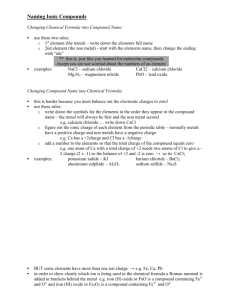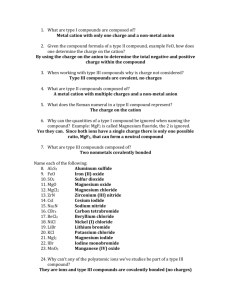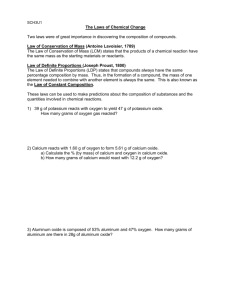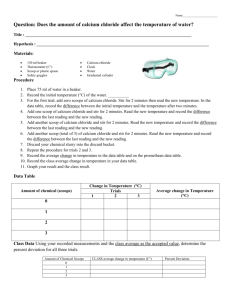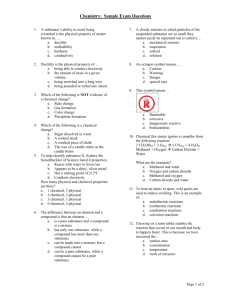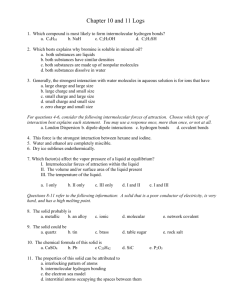Team Learning ws ch 4 answers
advertisement
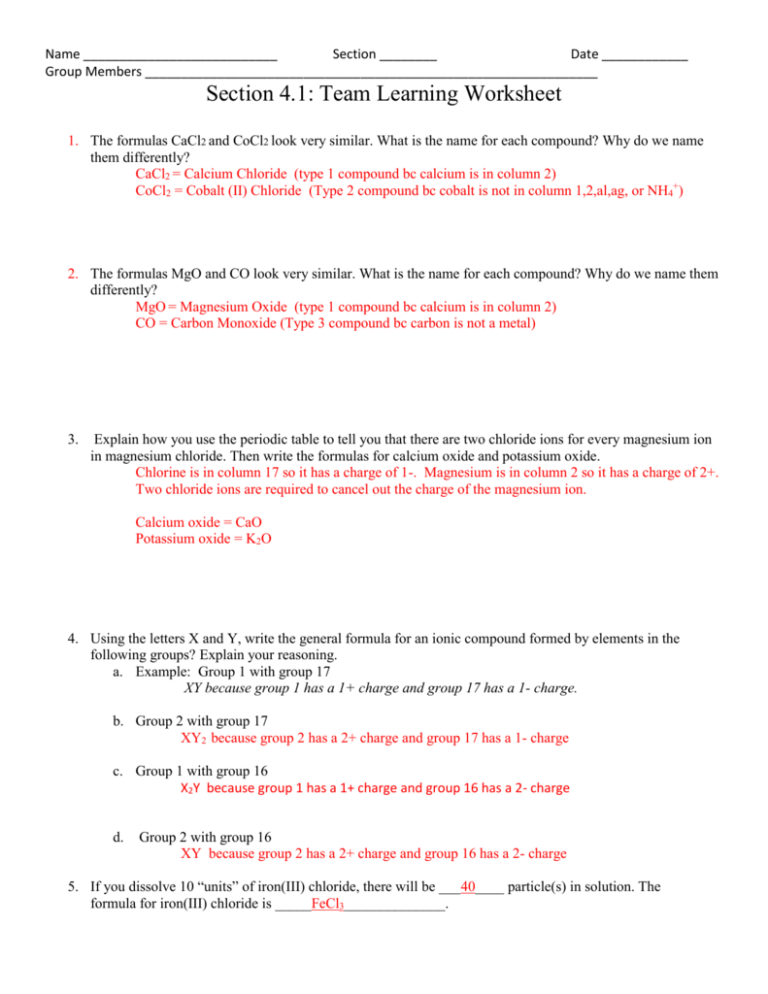
Name ___________________________ Section ________ Date ____________ Group Members _______________________________________________________________ Section 4.1: Team Learning Worksheet 1. The formulas CaCl2 and CoCl2 look very similar. What is the name for each compound? Why do we name them differently? CaCl2 = Calcium Chloride (type 1 compound bc calcium is in column 2) CoCl2 = Cobalt (II) Chloride (Type 2 compound bc cobalt is not in column 1,2,al,ag, or NH4+) 2. The formulas MgO and CO look very similar. What is the name for each compound? Why do we name them differently? MgO = Magnesium Oxide (type 1 compound bc calcium is in column 2) CO = Carbon Monoxide (Type 3 compound bc carbon is not a metal) 3. Explain how you use the periodic table to tell you that there are two chloride ions for every magnesium ion in magnesium chloride. Then write the formulas for calcium oxide and potassium oxide. Chlorine is in column 17 so it has a charge of 1-. Magnesium is in column 2 so it has a charge of 2+. Two chloride ions are required to cancel out the charge of the magnesium ion. Calcium oxide = CaO Potassium oxide = K2O 4. Using the letters X and Y, write the general formula for an ionic compound formed by elements in the following groups? Explain your reasoning. a. Example: Group 1 with group 17 XY because group 1 has a 1+ charge and group 17 has a 1- charge. b. Group 2 with group 17 XY2 because group 2 has a 2+ charge and group 17 has a 1- charge c. Group 1 with group 16 X2Y because group 1 has a 1+ charge and group 16 has a 2- charge d. Group 2 with group 16 XY because group 2 has a 2+ charge and group 16 has a 2- charge 5. If you dissolve 10 “units” of iron(III) chloride, there will be ___40____ particle(s) in solution. The formula for iron(III) chloride is _____FeCl3______________. Name ___________________________ Section ________ Date ____________ Group Members _______________________________________________________________ 6. If you dissolve 5 “units” of Pb(NO3)2, there will be __15_____ particle(s) in solution. The name of Pb(NO3)2 is ______lead (II) nitrate________________. 7. If you dissolve 8 molecules of HCl, there will be ___16____ particle(s) in solution. The name of HCl is ___Hydrochloric Acid__________________. 8. If you dissolve 7 “units” of K2Cr2O7, there will be ___21____ particle(s) in solution. The name of K2Cr2O7 is ______Potassium Dichromate_________________________. 9. If you dissolve 6 “units” of calcium hydroxide, there will be __18_____ particle(s) in solution. The formula for calcium hydroxide is ____Ca(OH)2______________. Explain any problems with each of the given names. Then, identify the formula for each compound with the given name (there may be more than one possible answer) and provide the correct name for this compound (some of the original names are correct) Name Barium dichloride Problem Should be named as a type I Formula BaCl2 Correct name Barium chloride Carbon oxide Should use prefixes bc it’s a type 3 CO Carbon Monoxide Copper (II) sulfate NONE CuSO4 Iron oxide Should have a roman number bc its type 2 FeO Diphosphorus pentoxide NONE P2O5 Potassium sulfide NONE K2S Perchloric acid NONE HClO4 Sulfur hexafluoride NONE SH6 Magnesium phosphide NONE Mg3P2 Calcium (II) nitrate Should not have a roman numeral bc it’s a type 1 Ca(NO3)2 Iron (II) oxide Calcium nitrate Name ___________________________ Section ________ Date ____________ Group Members _______________________________________________________________
